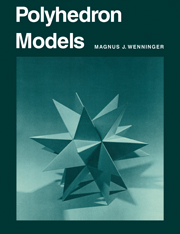Book contents
- Frontmatter
- Dedication
- Contents
- Preface to 1978 reprint
- Preface
- Foreword
- Introduction: uniform polyhedra
- Mathematical classification
- Section I The Convex Uniform Polyhedra: The Platonic and Archimedean Solids
- Section II Some Stellations and Compounds
- Section III Non-convex Uniform Polyhedra
- Commentary
- General instructions for making models of non-convex polyhedra
- Non-convex polyhedra (67–109)
- Commentary on non-convex snub polyhedra
- Non-convex snub polyhedra (110–119)
- A final comment
- Epilogue
- References
- List of models
Commentary
from Section III - Non-convex Uniform Polyhedra
Published online by Cambridge University Press: 05 August 2015
- Frontmatter
- Dedication
- Contents
- Preface to 1978 reprint
- Preface
- Foreword
- Introduction: uniform polyhedra
- Mathematical classification
- Section I The Convex Uniform Polyhedra: The Platonic and Archimedean Solids
- Section II Some Stellations and Compounds
- Section III Non-convex Uniform Polyhedra
- Commentary
- General instructions for making models of non-convex polyhedra
- Non-convex polyhedra (67–109)
- Commentary on non-convex snub polyhedra
- Non-convex snub polyhedra (110–119)
- A final comment
- Epilogue
- References
- List of models
Summary
You have now seen the stellation process applied to the Platonic solids and two of the Archimedean solids. You have also seen that it leads to very few uniform polyhedra. In fact only the three dodecahedral stellations and one icosahedral stellation turn out to be uniform. You may recall that a polyhedron is uniform if all its faces are regular polygons (these now include the regular stars) and all its vertices are alike. The list so far contains the five Platonic solids, the thirteen Archimedean solids and the four Kepler-Poinsot solids. Are there any more uniform polyhedra? It may surprise you to learn that there are at least fifty-three more! How were they ever discovered? Thirty-seven of them are due to Badoureau (1881) who systematically considered each of the Platonic and Archimedean solids in turn with a view to finding regular polygons or regular stars on their facial planes or cutting through the interior of these solids. This is a different approach from that of stellation. If such a polygon is found, it is evident that its vertices coincide with some of the vertices of the related convex polyhedron. The planes of these polygons may intersect. If portions of the solid are removed symmetrically, another uniform polyhedron may result. This process is called faceting, a sort of reverse of stellating. Stellating implies the addition of cells to a basic polyhedron which serves as a core. Faceting implies the removal of cells, so that the basic polyhedron may still be imagined as a case or enclosing web for the new one. If you examine Kepler–Poinsot solids from this point of view you will see that the small stellated dodecahedron and the great dodecahedron can both be derived by faceting an icosahedron. The vertices of the former and the edges of the latter coincide respectively with the vertices and edges of an icosahedron imagined as a case enclosing them. If you examine the models you will see this very plainly.
- Type
- Chapter
- Information
- Polyhedron Models , pp. 98 - 99Publisher: Cambridge University PressPrint publication year: 1971



